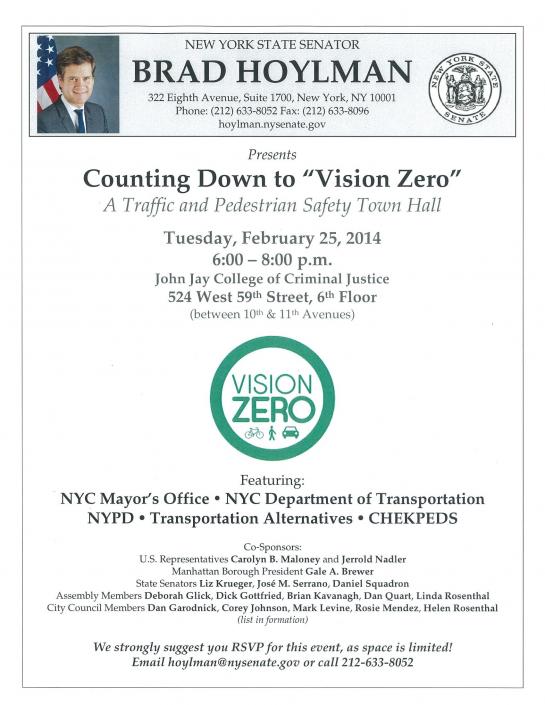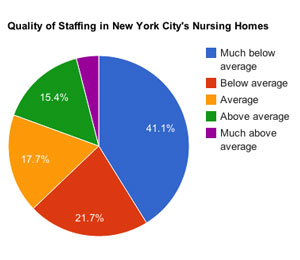To discuss the implementation of Vision Zero to reduce pedestrian injuries and deaths related to traffic accidents, New York State Senator Brad Holyman held a “Traffic and Pedestrian Safety Town Hall” at the John Jay College of Criminal Justice tonight. See below for more info.

Manhattan DA Cy Vance asks for NYC DAs to become involved in the Vision Zero task force to reduce severe personal injury and deaths related to traffic accidents
 Manhattan District Attorney Cy Vance cares about traffic accidents in the city and believes district attorneys should be integrated into the Vision Zero Task Force. All 5 New York City DAs were invited to a City Council Vision Zero Hearing yesterday but only Cy Vance was present. Vance came equipped with a list of solid recommendations that were presented by his Chief Assistant DA Karen Friedman Agnifilo.
Manhattan District Attorney Cy Vance cares about traffic accidents in the city and believes district attorneys should be integrated into the Vision Zero Task Force. All 5 New York City DAs were invited to a City Council Vision Zero Hearing yesterday but only Cy Vance was present. Vance came equipped with a list of solid recommendations that were presented by his Chief Assistant DA Karen Friedman Agnifilo.
The DA believes that prosecutors would be able to make better decisions in holding reckless motorists responsible if they were more involved. The DAs support could also be useful in implementing initiatives that require action by Albany.
Read more in Street Blog
To protect their children from car accidents, parents want a speed bump on a busy school street in Harlem, NY
Many students and parents have come close to being hit by a car on East 109th street between Second and Third Avenues in Manhattan, New York where five schools are located. Parents say that the street is dangerous and that motorists speeding have often come close to hitting pedestrians.
A petition has been launched to ask for the installation of a speed bump on the street to slow down the traffic.
Read more in the New York Daily News
Nursing home abuse and neglect in New york City: 5 places where you never want to send your loved ones

Low rated New york City nursing homes accumulate complaints of abuse and neglect and little is being done to improve the situation. Unlike other states, New York does not have a mandated minimum staff ratio or a minimum amount of hours that nursing staff is required to devote to nursing home residents. These staffing deficiencies can lead to horrific situations of nursing home abuse and neglect. The Gotham Gazette recently published five articles that looked in depth at the inspection reports, complaints and court reports for five of the lowest rated nursing homes in the city.
The Mosholu Parkway Nursing and Rehabilitation Center is so understaffed that it threatens the health and well-being of its residents. A few years ago, a resident who was supposed to be supervised when he smoked put his wheelchair bed sheet on fire and was engulfed by flames for 4 minutes until the fire was extinguished. He died from his injuries after a year of pain and suffering. Physical abuse of residents by other residents is also common at this nursing home where residents with violent behavior are not properly monitored and managed. Inspections in recent years show serious deficiencies in healthcare as well as 12% of residents suffering from bedsores, double the national average. The place is badly managed and disorganized.
Continue reading →
Product Liability: Nissan recalls some Frontier pick up trucks
A defective circuit breaker in some Nissan Frontier pickup trucks may cause a fire therefore Nissan is recalling 16,838 model years 2012 through 2014 in North America. No accidents or injury have been reported so far.
Read more at Reuters.com
To prevent bicycle accidents, a new bike lane may be created along Bond Street in Boerum Hill, Brooklyn, New York
31 Bicycle Accidents that injured cyclists have been reported since 1995 on Bond Street in Boerum Hill, Brooklyn, NY. Everyday close to 400 bicyclists use this road as a downton-bound connection to Brooklyn’s offices and the Manhattan and Brooklyn bridges. To protect bicycle users from future accidents, the New York City Department of Transportation proposed the creation of a five foot wide bikers-only lane except between Third and Douglass streets and between Wyckoff and Schermerhorn streets, where it morphs into a shared lane for cars and bike riders. The proposal was presented by the NYC DOT to the Community Board’s transportation committee last week and was received positively. The full community board’s vote is scheduled for March 12th.
Read more in the Brooklyn Paper
Click here to download the NYC DOT presentation.
25 year old pedestrian dies in a New York City Sanitation Truck Accident
A deadly truck accident happened yesterday in New York. A 25 year old rabbinical student was hit by a garbage truck as he was in the crosswalk on Kingstone Ave at Caroll St. in Crown Hights, Brooklyn. The pedestrian had the “walk signal” when he stepped in the crosswalk. According to witnesses, when the pedestrian realized that the truck driver didn’t see him, he tried to walk back but he was struck by the side of the truck and ran over. He died at the scene.
Read more in the Daily News
Trial Advocacy: Case for the Rhetorical Question as a Summation Technique
 In their Trial Advocacy column, New York Personal Injury Lawyers Ben Rubinowitz of Gair, Gair, Conason, Rubinowitz, Bloom, Hershenhorn, Steigman & Mackauf and Evan Torgan of Torgan & Cooper write: The rhetorical question is an effective and persuasive tool for summation. It is subtle in its delivery and potent upon its receipt. When used properly, it can persuade a jury without the insult of a more heavy-handed approach. A seasoned and accomplished trial attorney has to ask, what could be better?
In their Trial Advocacy column, New York Personal Injury Lawyers Ben Rubinowitz of Gair, Gair, Conason, Rubinowitz, Bloom, Hershenhorn, Steigman & Mackauf and Evan Torgan of Torgan & Cooper write: The rhetorical question is an effective and persuasive tool for summation. It is subtle in its delivery and potent upon its receipt. When used properly, it can persuade a jury without the insult of a more heavy-handed approach. A seasoned and accomplished trial attorney has to ask, what could be better?
Following is the article
The art of persuasion comes in many forms. It is the manner in which the trial lawyer chooses to present certain facts that will serve as the driving force behind a successful outcome. Since every aspect of the trial should be conducted with an eye toward summation-toward creating the most powerful argument that can be advanced-the trial lawyer must be acutely aware of how each part of the trial will affect the summation.
Continue reading →
Does General Motor voluntarily put consumers at risk of a car accident by not recalling all cars with Ignition Switch Problems?
A defective ignition switch can turn off the engine and disable the airbag on six different models of General Motors cars but last week the company decided to only recall two models even though management is perfectly aware that 4 other models have the same defect.
Read here the investigation of Christopher Jensen from the New York Times.
Drive as I say not as I do: Mayor de Blasio’s car caught on tape speeding, violating stops and endangering pedestrians
Mayor Bill de Blasio who has been passionately advocating safe street initiatives to reduce traffic accidents is not practicing what he is preaching. A CBS video shows the mayor’s car engaged in multiple reckless driving behaviours: blowing traffic stops, speeding 15 miles over the authorized limit, changing lanes without signaling and parking on the pedestrian crosswalk. That’s enough violations for a license suspension in New York.
 New York Personal Injury Attorneys Blog
New York Personal Injury Attorneys Blog


